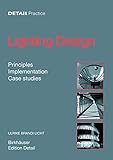Lighting Design : Principles, Implementation, Case Studies / Ulrike Brandi.
Material type: TextPublisher: Basel : Birkhäuser, [2012]Copyright date: ©2006Description: 1 online resourceContent type:
TextPublisher: Basel : Birkhäuser, [2012]Copyright date: ©2006Description: 1 online resourceContent type: - 9783034615693
- online - DeGruyter
| Item type | Current library | Call number | URL | Status | Notes | Barcode | |
|---|---|---|---|---|---|---|---|
 eBook
eBook
|
Biblioteca "Angelicum" Pont. Univ. S.Tommaso d'Aquino Nuvola online | online - DeGruyter (Browse shelf(Opens below)) | Online access | Not for loan (Accesso limitato) | Accesso per gli utenti autorizzati / Access for authorized users | (dgr)9783034615693 |
Frontmatter -- Content -- Introduction -- Daylight and Well-Being -- Daylight Characteristics and Basic Design Principles -- Daylight Control -- Light for the Public Utility Company in Schönebeck -- Light and Shadow – Design of a Church -- Light for the New Mercedes Benz Museum in Stuttgart -- Light Control: a Part of Facility Management -- Procedure for Planning Artificial Light in Buildings -- The Lighting Designer’s Position from a Contractual Point of View -- Daylight as a Building Material -- Standards and Regulations -- Bibliography (selection) -- Directory of Manufacturers of Daylight Systems (selection) -- Picture Credits
restricted access online access with authorization star
http://purl.org/coar/access_right/c_16ec
A concise, systematic introduction to natural and artificial lighting design More than any building material, light produces spatial effects, generates moods, and "stages” architectural designs. In well-lit spaces, we feel good, and we are capable and effective; light promotes health. Moreover, especially in office buildings, the combination of a sensible natural lighting design with a corresponding approach to artificial lighting is a decisive factor in energy conservation. Assembled by experienced authors and experts from the worlds of practice and teaching, this new volume in the series Detail Practice provides an introduction to the most important aspects of natural and artificial lighting design. In addition to straightforward planning rules - such as ground plan design, building orientation, and the structuring of facades - it also introduces and explains current natural and artificial lighting systems with the help of example projects.
Kompakte, systematische Einführung in die Grundlagen der Tages- und Kunstlichtplanung Mehr als jedes verwendete Material bestimmt das Licht Raumwirkungen, erzeugt Stimmungen, inszeniert Architektur. In gut belichteten Räumen fühlen wir uns wohl und sind leistungsfähig, Licht fördert die Gesundheit. Darüber hinaus trägt eine sinnvolle Tages- und darauf abgestimmte Kunstlichtplanung - gerade in Bürogebäuden - wesentlich zur Energieeinsparung bei.Zusammengestellt von erfahrenen Fachautoren aus Praxis und Lehre, bietet der neue Band der Reihe Detail Praxis wichtige Grundlagen zur Tages- und Kunstlichtplanung. Neben einfachen Planungsregeln wie Grundrissgestaltung, Gebäudeorientierung und Fassadengliederung werden aktuelle Tages- und Kunstlichtsysteme vorgestellt und an Beispielprojekten erläutert.
Mode of access: Internet via World Wide Web.
In English.
Description based on online resource; title from PDF title page (publisher's Web site, viewed 29. Nov 2021)


